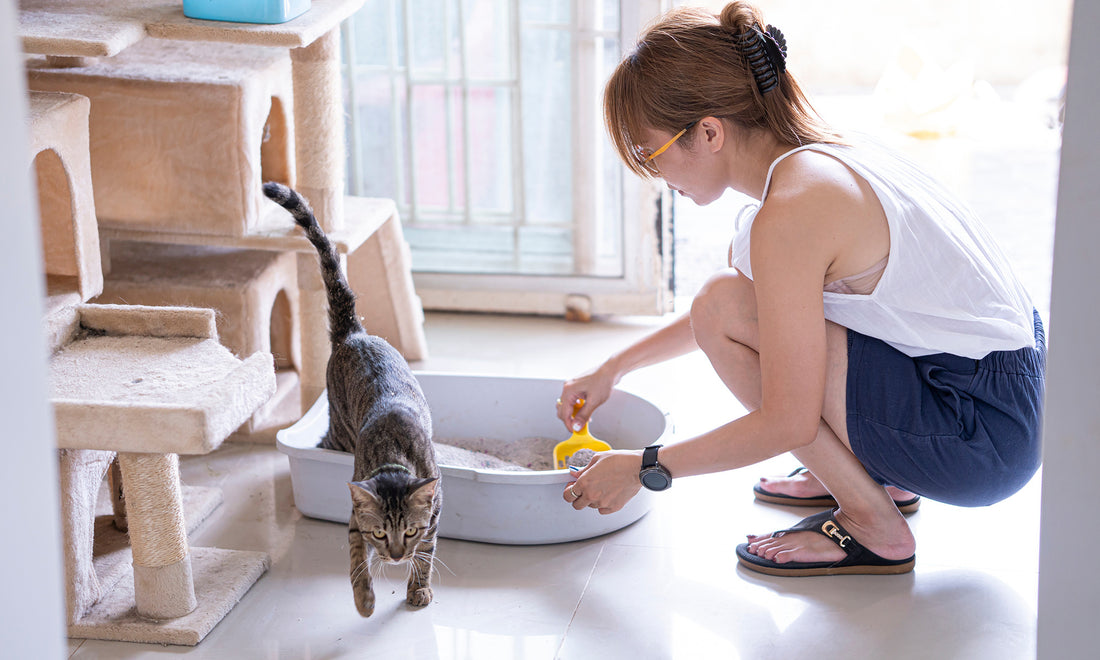
How to Keep Your Cat’s Litter Box From Smelling Up the Whole House
How to Keep the Litter Box from Smelling
Cats are cute and all, but their stench certainly isn’t. Lucky for you, cat odor can often be controlled with the right cat litter, litter box set-up and cleaning schedule. The root of the problem often lies in the kitty litter itself, which is why it’s so important to find the best cat litter for odor control — clumping and non-clumping cat litters, depending on your cat’s needs and preferences. But once you lay the foundation, it’s crucial that you, as their caretaker, maintain everything so it looks nice and smells fresh. Trust us, having cats doesn’t mean that your cat’s litter box has to smell up the whole house. With the right system in place, you can prevent odors from happening in the first place — and when the inevitable moment happens, you’ll know exactly what to do to get rid of them for good. Consider everything you need to know about how to keep any unwanted cat odors at bay, including the reason why it happens in the first place and what you should do when it’s getting out of control. Plus, find helpful tips on choosing the best cat litter for odor control, ranging from classic clay options to Skoon’s Diatom pebbles that change color when the litter box needs to be cleaned.
The Reason Why Your Cat’s Litter Box Smells So Bad

It’s simple, really: A litter box is a cat’s version of a bathroom. Unlike the ones humans use, cats have no way of flushing something away and wiping themselves clean. That means that the odor will continue to build up over time until it’s addressed. It’s also important to consider that cat urine is very different from humans. In fact, it’s said to be five times more concentrated, which, uh, could be the reason why it has such a pungent odor. An average cat also goes #1 in the litter box roughly five times a day, which means that strong scent will be multiplied over time. Note: If you notice a particularly strong or strange odor, it may be a sign of a more significant cat health issue, including a urinary tract infection. If that’s the case, take your cat to the vet to be sure.
How to Prevent Unwanted Litter Box Odors

Your cat isn’t the only culprit here: It’s up to you to pick the best cat litter for odor control, make sure your cat’s litter box is set up correctly, and keep up with cleaning it regularly. Once you figure out the right kind of cat litter for your budget and needs (more on that below), consider the following tips and tricks to avoid and prevent unwanted odors:
- Make sure there is one litter box per cat, plus one more. All litter boxes should be placed in visible, well-ventilated areas, far away from the cat’s food.
- Litter should be at least two inches deep, so the urine can be absorbed entirely, and your cat can adequately cover the waste.
- Plastic litter boxes are especially helpful for keeping odor at bay, but there are other popular options on the market that work just as well, including Skoon’s disposable kitty litter box. If you opt for plastic, wash the litter box and scoop weekly with mild, unscented dish detergent. Keep in mind that some cleaning products can be toxic to cats, and others, like ammonia or citrus oils, can deter cats from using the litter box in the future.
- Replace litter boxes once a year. Over time, your cat’s claws will make minor grooves in the litter box, making it more likely to hold onto odor. Donate your used litter box to a nearby shelter (if they will accept them, of course) when it’s time to start fresh.
- Sprinkle a thin layer of baking soda to the bottom of the litter box to absorb odor. You can also buy clay cat litter containing baking soda for a similar effect. Sprinkle a cat-specific deodorizer on top of the litter to mask any unwanted smells. Sometimes, these may be fragranced with essential oils, which will make your house smell nice but may be off-putting for your furry friend.
How to Find the Best Cat Litter for Odor Control

If you use clumping cat litter, then it’ll be easier to see just how much liquid has been absorbed, giving you a clear indication of when the litter box needs a quick clean or a complete overhaul. Non-clumping cat litter, on the other hand, is a little tricker, which is why all cat owners must get in the routine of cleaning their cat’s litter box well and often — daily for scooping out clumps and feces and weekly for a complete litter refresh. As a whole, both kinds of kitty litter are equally effective in absorbing odor, but some materials may be better than others. Nearly every litter you find on the market — both clumping and non-clumping cat litter — will absorb odor, so you really can’t go wrong with any brand you see in the pet aisle. Just steer clear of paper pellet cat litter if the scent is your primary concern. This kind of cat litter is best for kittens, older cats, or those with injured paws since it’s soft to the touch. It’s typically made out of recycled newspaper pieces, which isn’t very absorbent. Go with these options instead, often available in clumping and non-clumping formulas:
- Clay cat litter does a great job of absorbing the odor of whatever your cat leaves behind, but it also serves double-duty, working to deodorize other parts of your house or garden.
- Crystal cat litter is a non-clumping option made out of silica crystals. Along with being extremely lightweight (a bonus for both parties involved), this litter absorbs odor well and lasts longer between cleanings.
- Pine cat litter is a more natural way to absorb cat odors. It’s available in non-clumping and clumping, both of which are equally lightweight and dust-free.
- Cat litter made from Diatom pebbles, like Skoon, replicate a microscopic, sponge-like structure that absorbs urine while trapping and eliminating odor. FYI: The pebbles will turn an off-white color when it’s time for a refresh.
How Skoon Helps You Avoid Unwanted Cat Smells

If you really want to keep odors at bay, then pick up Skoon’s disposable kitty litter box. Fill the litter box two inches deep with litter and then maintain it daily by scooping out solids and stirring the pebbles to maximize absorption. You’ll know when it’s time to dispose and replace the litter because the pebbles will turn an off-white color. As for the box itself, it can last about two to three weeks per cat. The real advantage here is that you don’t have to deal with litter box liners or any smells that settle in over time, the major problems you’ll find with other litter boxes on the market. If you want to give your kitty a cleaner, better cat litter option, get started with Skoon. We offer a variety of non-clumping scents, ideal for kittens and multi-cat households.

